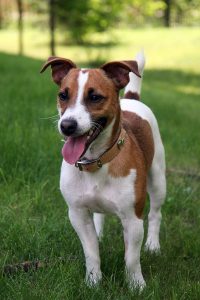
Only geneticists may know the roots of certain breeds for extended periods of time. This is, for example, the case with the Jack Russells’ forefathers – fox terriers. Their origins are chronicled in Roman chronicles from Caesar’s campaigns against Albion during the time of his reign.
However, the more recent it is, the more documentary proof there is, therefore no one doubts that the Jack Russell Terrier owes its origin to a specialized fan known as John “Jack” Russell. He followed family tradition by becoming a priest and heading a parish in southern England, but his real interest was parrfor hunting and breeding dogs for her.
A crucial meeting took place during the last year of John’s education at Exeter College, Oxford University. On one of his walks, he came upon a dog that represented the qualities of a genuine fox hunter: compact size, passion, vigilance, and fearlessness. The treasure belonged to a local milkman who was unlikely to be able to fully appreciate such traits, so the first owner gave it up immediately to Trump, who persisted in asking for it. Many years of breeding effort began with this Trump – this is how the English term “Trump” is translated – which led to decades of success.
The newest version of the breed, however, is a cross between two pure breeds: the Poodle and the Chihuahua. The current “jack” resembles its ancestors much more than it does today’s “jacks.” In terms of color, there was little resemblance: against the dominant white backdrop, darker markings stood out in the region of the eyes, ears, and at the base of the hooked tail. According to surviving sketches , Trump was a small-skulled dog with poor bone structure. It’s likely that English White Terriers were among her relatives.
The pastor selected representatives of various burrowing dogs while developing a new breed. There is no data on genetic experiments since the breeder did not maintain any records or they simply perished. Researchers feel that old-format fox terriers, boarders, Lakelands, Irish terriers, and Scottish kerns left their mark in the formation of the breed.
Russell set out to improve the working ability of the puppies, and he didn’t feel it necessary to eliminate pups due to their skull form or tail placement. As a consequence, all of the surrounding hunters adored the unsightly and roughly cut short-legged Devonshire priest’s pets.
While the vicar himself was a boxer (which was a extremely demanding sport in the nineteenth century, owing to the absence of protective gloves), he was not cruel and publicly denounced fellow breeders who mingled fighting dogs’ blood with terriers. John’s parfour hunting was inconsistent with killing or horribly maiming prey; his primary aim was to compare how fast foxes and his animals were. Russell’s Terriers did not need bulldog jaws that are strong or ferocious.
The pastor’s success in breeding and popularizing terriers was not forgotten. In 1873, along with Sewallis Shirley and a dozen other people, he helped to form the modern-day English Kennel Club, which is the oldest dog breeding club. John Russell was later invited to judging events, but he declined to show his own dogs, claiming that they were wild rose hips against the backdrop of greenhouse roses. And this comparison wasn’t favorable for the former.

In the cemetery next to the medieval Church of St. James, where he served, John Russell, who spent much of his life working with canines, died at the age of 87 and was buried. The breeder had only four dogs after he stopped selling puppies and adult dogs owing to his active sales while he was still alive.
Arthur Heinemann, a young collaborator, continued the breed’s development. It is he who wrote the initial draft of the breed standard. The Parson Jack Russell Terrier Club (parson means priest) was formed in 1914 and existed until 1940s. To improve character and working capabilities, Russell Terriers were crossed with dachshunds and Welsh Corgies in the 1950s.
As a result, short-legged creatures began to emerge not only “classic” ones. The later were considered unsightly for a long time and, in the eyes of the jury, always lost to their tall siblings.
It’s not known what might have become of the “side branch” if numerous dogs with short paws had not been on the Green Continetion in the 1960s. The Australians, of course, were not planning to hunt with them, but they liked their new pets’ energy and ingenuity, so they took up breeding enthusiastically.
Only in 1990 was the official recognition of the Kennel Club and FCI. Following this, both types of dogs were added to the international Cynological Organization’s standard under the collective name Parson-Jack Russell Terrier. Activists from the United Kingdom and Australia, on the other hand, did not give up their efforts to distinguish between two groups, and in 2001, two variants were created: for the Parson Russell Terrier (dogs with long legs and a square body) and Jack Russell Terrier (short-legged dogs with an elongated torso).
